Related Research Articles

Malay is an Austronesian language officially spoken in Indonesia, Brunei, Malaysia and Singapore and unofficially spoken in East Timor and parts of Thailand. It is spoken by 290 million people across the Malay world.

Minangkabau people, also known as Minang, are an ethnic group native to the Minangkabau Highlands of West Sumatra, Indonesia. The Minangkabau's West Sumatran homelands was the seat of the Pagaruyung Kingdom, believed by early historians to have been the cradle of the Malay race, and the location of the Padri War.

Riau is a province of Indonesia. It is located in the central eastern coast of Sumatra along the Strait of Malacca. Until 2004 the province included the offshore Riau Islands, a large group of small islands located east of Sumatra Island and south of Singapore, before these islands were split off as a province in July 2004. The provincial capital and the largest city of Riau is Pekanbaru. The province shares land borders with North Sumatra to the northwest, West Sumatra to the west, and Jambi to the south. The total area for Riau province is 87,023.66 square kilometres (33,600.02 sq mi), which stretches from the slopes of the Bukit Barisan to the Strait of Malacca. Riau has a wet tropical climate with average rainfall ranging between 2000 and 3000 millimeters per year, and the average rainfall per year is about 160 days. Riau is currently one of the richest provinces in Indonesia and is rich in natural resources, particularly petroleum, natural gas, rubber, palm oil and fibre plantations. Extensive logging and plantation development in has led to a massive decline in forest cover Riau, and associated fires have contributed to haze across the larger region.

West Sumatra is a province of Indonesia. On the west coast of the island of Sumatra, the province has an area of 42,012.89 km2, and it had a population of 4,846,909 at the 2010 census and 5,534,472 at the 2020 census. The province includes the Mentawai Islands off the coast and borders the provinces of North Sumatra to the north, Riau and Jambi to the east, and Bengkulu to the southeast. West Sumatra is sub-divided into twelve regencies and seven cities. It has relatively more cities than other provinces outside of Java, although several of them are relatively low in population compared with cities elsewhere in Indonesia. Padang is the province's capital and largest city.
Datuk is a Malay title commonly used in Brunei and Malaysia, as well as a traditional title by Minangkabau people in Indonesia.
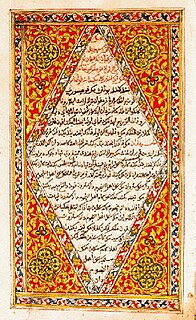
The Malay Annals, originally titled Sulalatus Salatin, is a literary work that gives a romanticised history of the origin, evolution and demise of the great Malay maritime empire, the Malacca Sultanate. The work which was composed sometime between the 15th and 16th centuries, is considered one of the finest literary and historical works in the Malay language.

Pagaruyung was the seat of the Minangkabau kings of Western Sumatra, though little is known about it. Modern Pagaruyung is a village in Tanjung Emas subdistrict, Tanah Datar regency, located near the town of Batusangkar, Indonesia.
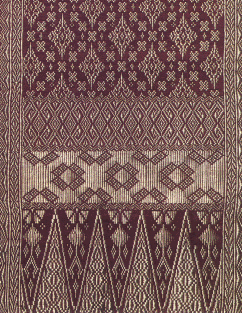
Songket is a Tenun fabric that belongs to the brocade family of textiles of the Malay world. It is hand-woven in silk or cotton, and intricately patterned with gold or silver threads. The metallic threads stand out against the background cloth to create a shimmering effect. In the weaving process the metallic threads are inserted in between the silk or cotton weft (latitudinal) threads in a technique called supplementary weft weaving technique.

Adityawarman was a king of Malayapura Suvarnabhumi, and is the successor of the Mauli dynasty based on central Sumatra. He was the cousin of Jayanegara, king of Majapahit from 1309–1328, and the grandson of Tribhuwanaraja, king of Melayu Kingdom. Adityawarman was awarded the Senior Minister of Majapahit (wreddamantri) and used this authority to launch Majapahit military expansion plans and conquered east coast region in Sumatra. Adityawarman then founded the royal dynasty of Minangkabau in Pagaruyung and presided over the central Sumatra region to take control of the gold trade between 1347 and 1375.

Malay was first used in the first millennia known as Old Malay, a part of the Austronesian language family. Over a period of two millennia, Malay has undergone various stages of development that derived from different layers of foreign influences through international trade, religious expansion, colonisation and developments of new socio-political trends. The oldest form of Malay is descended from the Proto-Malayo-Polynesian language spoken by the earliest Austronesian settlers in Southeast Asia. This form would later evolve into Old Malay when Indian cultures and religions began penetrating the region, most probably using the Kawi and Rencong scripts, some linguistic researchers say. Old Malay contained some terms that exist today, but are unintelligible to modern speakers, while the modern language is already largely recognisable in written Classical Malay of 1303 CE.
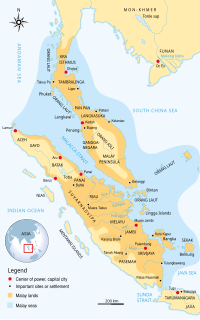
The Melayu Kingdom was a classical Buddhist kingdom located in Southeast Asia.

The Overseas Minangkabau is a demographic group of Minangkabau people of Minangkabau Highlands origin in West Sumatra, Indonesia who have settled in other parts of the world. Over half of the Minangkabau people can be considered overseas Minangkabaus. They make up the majority of the population of Negeri Sembilan and Pekanbaru. They also form a significant minority in the populations of Jakarta, Bandung, Medan, Batam, Surabaya and Palembang in Indonesia as well as Kuala Lumpur, Malacca, Penang, Singapore and Brunei Darussalam in the rest of the Malay world. Minangkabaus have also emigrated as skilled professionals and merchants to the Netherlands, United States, Saudi Arabia and Australia. The matrilineal culture and economic conditions in West Sumatra have made the Minangkabau people one of the most mobile ethnic group in Maritime Southeast Asia.

Malay Indonesians are ethnic Malays living throughout Indonesia. They are one of the indigenous peoples of the country. Indonesian, the national language of Indonesia, is a standardized form of Riau Malay. There were numerous Malay kingdoms in what is now Indonesia, mainly on the islands of Borneo and Sumatra. These included Srivijaya, the Melayu Kingdom, Dharmasraya, the Sultanate of Deli, the Sultanate of Siak Sri Indrapura, the Riau-Lingga Sultanate, the Sultanate of Bulungan, Pontianak Sultanate, and the Sultanate of Sambas. The 2010 census states that there are 8 million Malays in Indonesia, this number comes from the classification of Malays in East Sumatra and the coast of Kalimantan which is recognized by the Indonesian government. This classification is different from the Malaysia and Singapore census which includes all ethnic Muslims in the Indonesian archipelago as Malays.
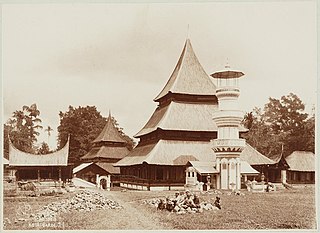
The Minangkabau Highlands is a mountainous area in the province of West Sumatra, located around three mountains—Mount Marapi, Mount Singgalang, and Mount Sago—in west-central Sumatra, Indonesia. The highlands are part of the Barisan Mountains, the largest mountain range in Sumatra. They are home to the Minangkabau people who refer them as Alam Minangkabau, or "the world of Minangkabau". This area formed a kingdom known from at least the 7th century as Malayu.
Sri Maharaja Sang Sapurba Paduka Sri Trimurti Tri Buana, (1245–1316) also known as Sri Nila Pahlawan, is a figure in the Malay Annals, highly revered as the legendary great ancestor of some of the major dynasties of the Malay world: Singapura, Malacca, Pahang, Johor, Perak, Kelantan, Terengganu and Siak Sri Indrapura. Legend has it that after his accession to Seguntang Hill with his two younger brothers, Sang Sapurba enters into a sacred covenant with Demang Lebar Daun the native ruler of Palembang, which laid the basis of the proper relationship between the Malay rulers and the subjects. The legendary sword believed to be carried by the king, the Cura Si Manjakini, is now formed part of the regalia of Perak Sultanate, whose rulers are said directly descended from the king. The details of Sang Sapurba stories are mainly composed of folklore and legends, and thus his historical existence is debated and disputed by modern historians. Even so, as De Jong argued in her article The Character of Malay Annals, the stories of the Malay Annals could have been realistically mixed with the historical figures and events.
The Indonesian Malaysians, also known as Anak Dagang are Malaysian citizens of Indonesian ancestry. Today, there are many Malaysian Malays who have lineage from the Indonesian archipelago and have played an important role in the history and contributed to the development of Malaysia, they have been assimilated with other Malay communities and are grouped as part of the foreign Malays or anak dagang in terms of race. The Malaysian census does not categorize ethnic groups from the Indonesian archipelago as a separate ethnic group, but rather as Malays. In Malaysia, the definition of Malay is a person who can speak Malay, is Muslim, and follows Malay traditions and customs, even non-natives who marry Malays and embrace Islam are also accepted as Malays. In Malaysia there is a political trend of trying to put all ethnic groups who speak Malay and happen to be Muslim under one banner - Malay. This is not the case in Indonesia where all ethnic groups have their own cultural identities that are recognized and respected by the government.
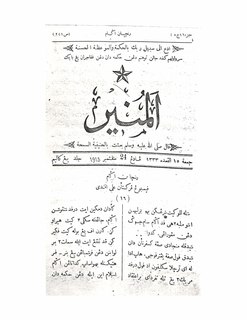
Al-Munir was an Islamic magazine, written in Arabic-Malay, published in Padang from 1911 until 1915. Inaugurated by the initiative of Abdullah Ahmad in early April 1911, Al-Munir was listed as the first Islamic mass media in Indonesia. The magazine was often associated with Al-Imam magazine published under the direction of Sheikh Tahir Jalaluddin in Singapore during 1906-1909. In addition to Abdullah Ahmad, several religious figures such as Abdul Karim Amrullah, Muhammad Thaib Umar and Sutan Muhammad Salim were recorded in the ranks of the editorial board.
Bijayendrawarman was the name of one a yuwaraja of the Malayapura kingdom, who ruled in the 14th century in the Pasaman Regency, West Sumatra, Indonesia. Bijayendrawarman's name is written in Lubuk Layang inscription, found in Pancahan village, in Rao Selatan district of Pasaman. It was stated that he built a stupa, in a place called Parwatapuri.
Lubuk Layang inscription, also known as Kubu Sutan inscription, is an inscription found in 1970 in Kubu Sutan, Lubuk Layang, Rao Selatan district, Pasaman Regency, of West Sumatra, Indonesia.
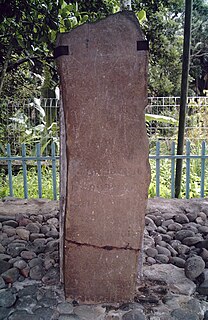
Kuburajo Inscription, also called Kuburajo I Inscription, is one of the many inscriptions left by King Adityawarman of central Sumatra. The inscription was found in Kuburajo village, Lima Kaum district, Tanah Datar Regency, West Sumatra, Indonesia in 1877 besides the main road from Batusangkar city to Padang city. The inscription was registered by N.J. Krom in Inventaris der Oudheden in de Padangsche Bovenlanden. The inscription is written in Sanskrit, and consists of 16 lines. This inscription was lost in 1987, but was rediscovered.
References
- 1 2 3 4 Kozok, Uli (2015). A 14th Century Malay Code of Laws: The Nitisarasamuccaya. Institute of Southeast Asian Studies. p. 38. ISBN 978-9814459747.
- 1 2 Hussein, Ismail; Deraman, Aziz; Al Ahmadi, Abd. Rahman (1995). Tamadun Melayu, Jilid III (in Malay). Dewan Bahasa dan Pustaka, Kementerian Pendidikan Malaysia. pp. 923–930. ISBN 9836248447.
- 1 2 3 Salleh, Abdul Razak; Ramza, Harry; Abdul Kadir, Mohammad Alinor (2015). Diaspora Adat dan Kekerabatan Alam Minangkabau: Sebuah Kepelbagaian Kajian Pemikiran (in Indonesian). Penerbit Kemala Indonesia. p. 82. ISBN 978-6021478127.